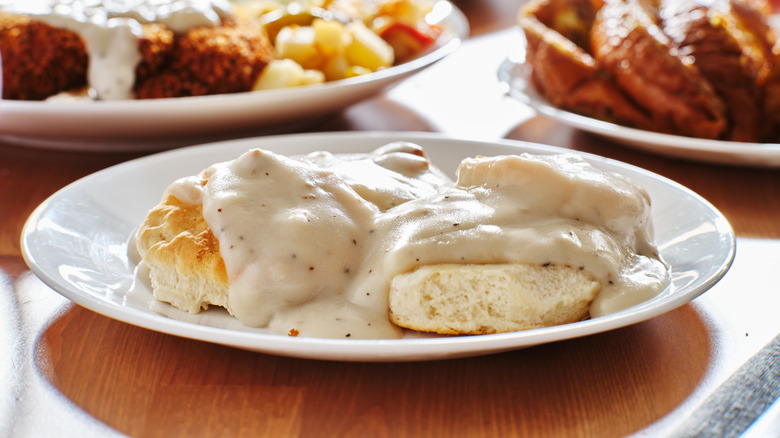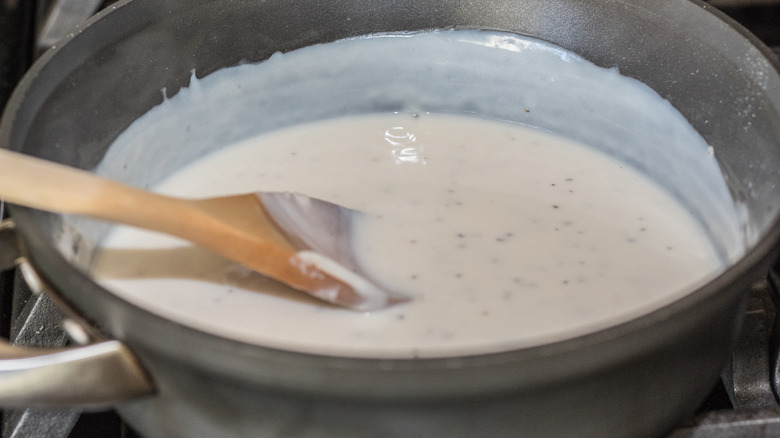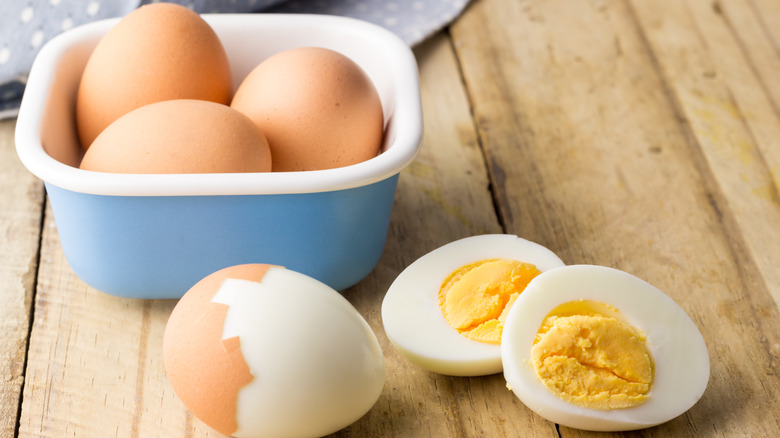Egg Gravy Is The Southern Breakfast Staple You Won't Find On Menus
Biscuits and gravy is as Southern as it gets. The biscuits go toe to toe with cornbread for the title of unofficial Bread King of Deep South Kitchens — but then there's the gravy. There's no contest, at least when it comes to breakfast. The thing is, Southern-style gravy isn't a single entity, and there's no set recipe. It's just something you grow up doing, as natural as making sweet iced tea on a sultry summer day. However, family-centric variations of country gravy certainly exist, and one of them is egg gravy.
Southern egg gravy doesn't mean pouring traditional sausage gravy over a fried egg or stirring scrambled eggs into plain white gravy. It's instead a gravy phenomenon in its own right. You'll rarely find it on restaurant menus, even in country cafes and roadside diners, but it's deeply engrained in humble Southern culinary culture. Some home kitchen chefs won't tell you how to make egg gravy, but it's much less clandestine than it appears. In fact, it involves staple ingredients residing routinely in pantries and refrigerators across the globe.
But you do have to know how to use those everyday items for making egg gravy. And, depending on whose kitchen is doling out the intel, there are several iterations, mostly involving what to do with the eggs.
What's in that Southern egg gravy
The so-called secret of egg gravy is really no secret at all, at least with the base ingredients. That's because they're essentially the same as any white country-style gravy. They routinely include oil, butter, or pan drippings; standard all-purpose flour; eggs; milk, water, cream, light-colored broth, or a combination of them; and your choice of seasoning, typically salt and pepper, maybe some garlic salt, and sometimes a fiery addition such as Creole seasoning or Tabasco sauce (which, incidentally, is a Southern sauce straight from the salt-dome Avery Island in Louisiana).
You'll make a gravy with those ingredients, per taste, as you would any kind of gravy, creating a roux and whisking until it thickens. The eggs generally jump into the mix at the end, and therein lies the anomaly. The eggs aren't merely beaten and poured in — they're hard-boiled first. Depending on preference or regional custom, the hard-boiled eggs get thinly sliced or diced into small, chunky bits, similar to how you'd chop them for egg salad. You could also gently crumble the eggs with your fingers.
As usual with homespun dishes, variations exist — as do tales of origin.
Variations and origin of Southern egg gravy
Southern tradition rules for the most part, with egg gravy being white and eaten for breakfast. But some recipes take them into dinner territory using turkey fat, onions, celery, or even giblets, joined by chopped eggs. Other chefs create an iconic country sausage gravy and toss the eggs into it, doling out a double dose of Southern breakfast goodness. Still others use bacon drippings for the roux, and then add diced cooked bacon to the gravy.
The feather-ruffling begins with arguments on how to incorporate the eggs. Hard-boiled is the common consensus, but some insist on slicing the eggs instead of chopping, which makes them more prominently displayed instead of blended for the greater-gravy-good. Then there are the true rebels who beat the eggs first and cover the gravy base with hot milk.
All these iterations come from home kitchens, becoming childhood comfort foods in many ways. Like other thick gravies in Southern communities, the origin arguably comes from necessity. With farming communities dependent on crop yields, underproductive seasons could leave hungry household bellies, elevating simple gravies that are filling, affordable, delicious, and accessible.
Egg gravy adds another layer of goodness and nutrition by bringing protein to the mix. With six to seven grams of protein in a single large egg, per Healthline, it's a healthy plus regardless of economics. Using eggs in gravy instead of meat also offers an alternative for meatless diets.



